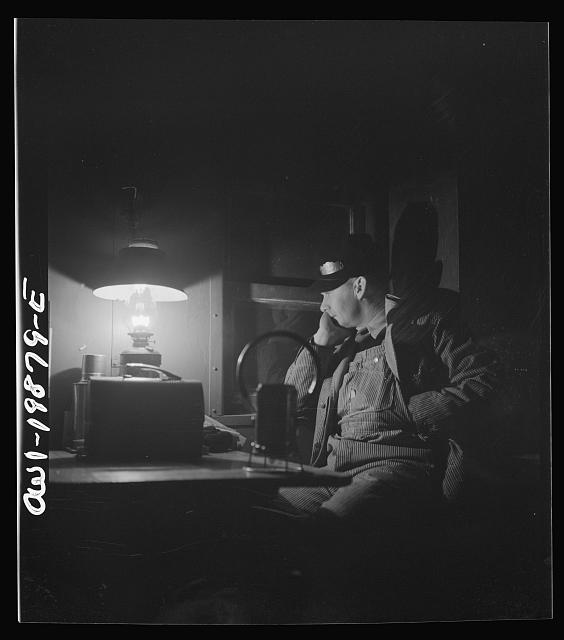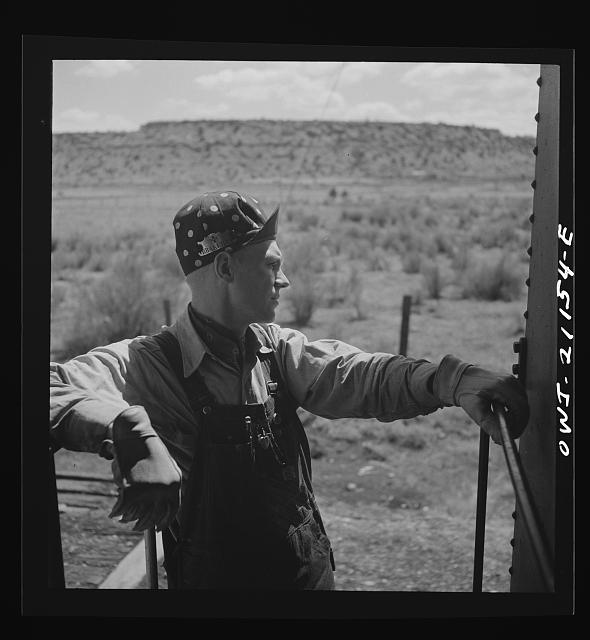Here are images of the caboose that steam-powered freight trains pulled behind them in the 1940s. The caboose functioned as a mobile home, providing facilities for working, cooking, sleeping, and even to some extent recreation.
The photos are mostly from a shoot of March 1943 on
Santa Fe freight trains pulled by steam locomotives between Chicago and Los Angeles. As captions note, there are one each from January and April on the Chicago and North Western Line.
In all cases the photographer was
Jack Delano and the assignment came from the Information Division of the
Farm Security Administration unit in the
Office of War Information.
All the photos come from the
Farm Security Administration/Office of War Information Collection in the Library of Congress
Prints and Photos Division. The captions are from notations on the film negatives and were prepared by P&P staff members. Click to view full size.
For more information, see my previous posts of Jack Delano's railroad photos
here and
here.

{C & NW RR, putting the finishing touches on a rebuilt caboose at the rip tracks at Proviso yard, Chicago, Ill. 1943 April}

{Freight train operations on the Chicago and Northwestern Railroad between Chicago and Northwestern Railroad between Chicago and Clinton, Iowa. The caboose is the conductor's second home. He always uses the same one and many conductors cook and sleep there while waiting for trains to take back from division points}

{Brakeman H.B. Van Santford riding on top of the caboose as the train on the Atchison, Topeka, and Santa Fe Railroad goes down from Summit to San Bernardino, California. The swing and head brakeman also ride on top of the cars for the entire distance}

{Conductor James M. Johnson and brakeman Jack Torbet of Waynoka, Oklahoma having lunch in the caboose on the Atchison, Topeka and Santa Fe Railroad between Waynoka, Oklahoma and Canadian, Texas}

{Belen, New Mexico. A brakeman on the Atchison, Topeka and Santa Fe Railroad C.G. Kirkland getting off the caboose}

{Atchison, Topeka, and Santa Fe Railroad. Brakeman L.E. Capsey preparing a meal in the caboose enroute to Gallup, New Mexico}

{Atchison, Topeka and Santa Fe brakeman Jack W. Torbet, left, and conductor James M. Johnson having lunch in the caboose enroute to Canadian, Texas}

{Conductor George E. Burton building a fire in the stove of the caboose on the Atchison, Topeka and Santa Fe Railroad enroute to Chillicothe, Illinois}

{Waynoka, Oklahoma. Brakeman Jack Torbet, sitting at the window of the caboose pulling out of Waynoka, Oklahoma on the Atchison, Topeka, and Santa Fe Railroad}

{Brakeman H. L. Duffield, watching the train from the window in the cupola of the caboose on the Atchison, Topeka, and Santa Fe Railroad between Emporia and Wellington, Kansas}

{Freight operations on the Indiana Harbor Belt railroad between Chicago, Illinois and Hammond, Indiana. The conductor uses hand brakes on the caboose to stop it as it coasts down a siding}

{Acomita, New Mexico. Brakeman R.E. Capsey standing on the platform of the caboose waiting to hop off as the train on the Atchison, Topeka and Santa Fe Railroad between Belen and Gallup, New Mexico pulls out to a siding}

{Freight train operations on the Chicago and Northwestern Railroad between Chicago and Clinton, Iowa. Riding in the caboose can sometimes, on fairly long, fast runs, be very lonely with nothing to do but watch the landscape. The crew of a way-freight making deliveries and pick-ups all the time is kept constantly busy switching cars. Runs such as the one to Clinton are much sought after, and only go to men with the high seniority ratings.}
1943 Jan.
-------------
An endnote:
Although growing numbers of women were entering the workforce in 1943, there were relatively few women in railroad jobs and those who had them mainly did yard work. Their numbers would grow during the rest of World War II, but there's no record (that I can find) of women riding the caboose or elsewhere in the freight trains themselves. Although many male railroad workers served in the armed forces, local draft boards could and routinely did give deferments to men in this occupation.
Some sources on this topic:
Women railroad workers:

{Kansas City, Missouri. Mildred Williams, one of several women freight handlers employed at the Atchison, Topeka, and Santa Fe freight depot}

{Women wipers of the Chicago and North Western Railroad cleaning one of the giant "H" class locomotives, Clinton, Iowa. Mrs. Marcella Hart and Mrs. Viola Sievers. 1943 April}

{Mexican-American Women Railroad Workers; source: forchicanachicanostudies.wikispaces.com}



















1 comment:
Great pictures and captions.
Post a Comment